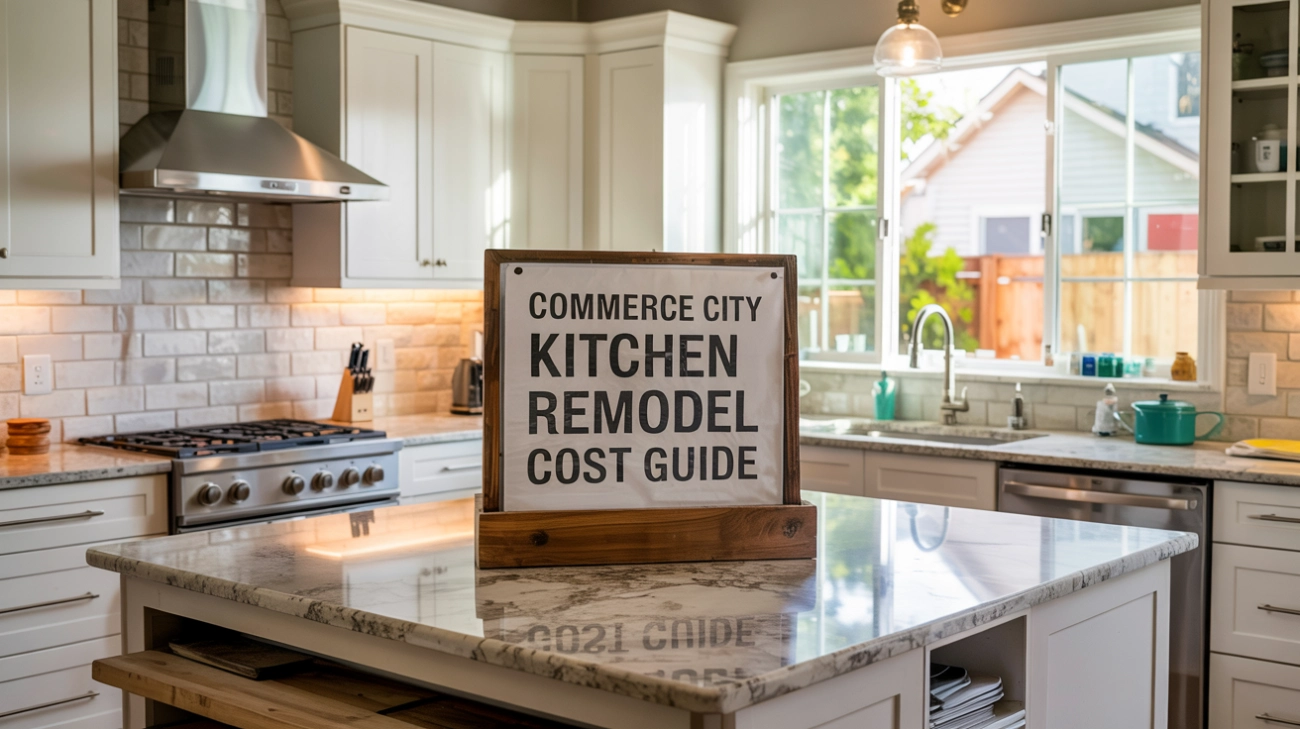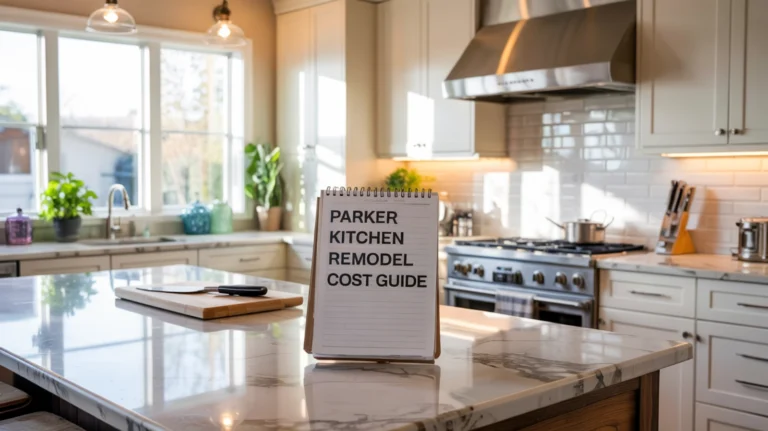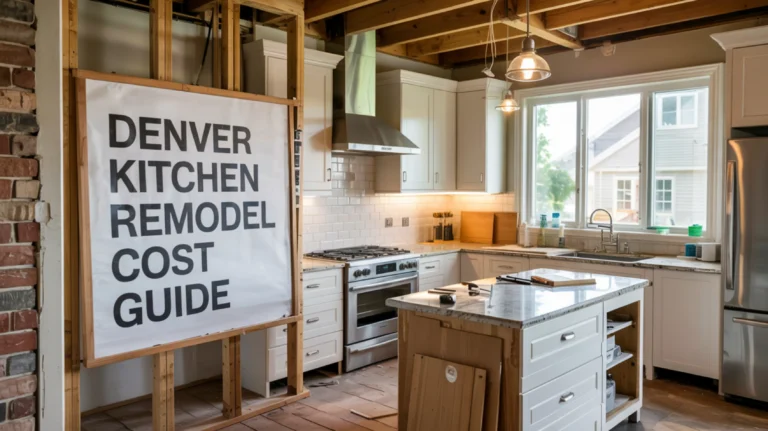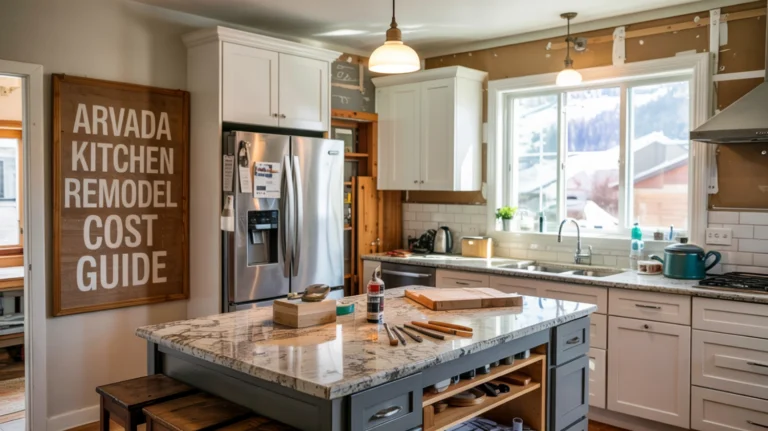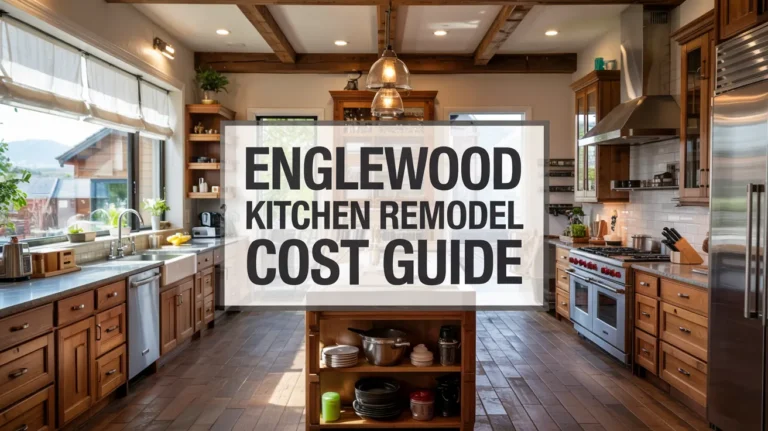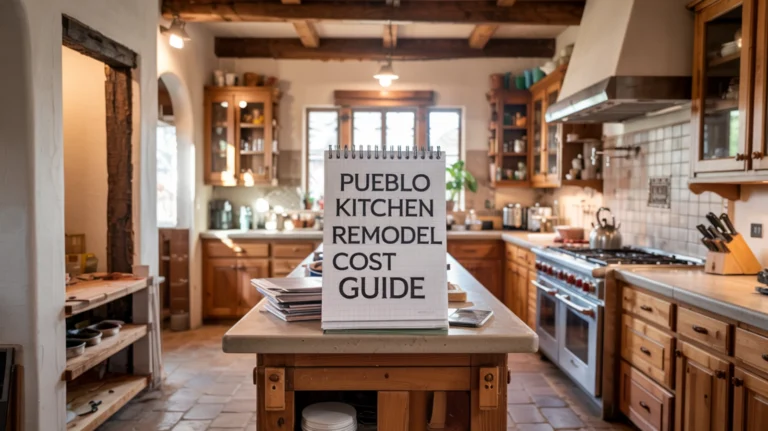Kitchen remodels in Commerce City aren’t remotely comparable to those national averages you see online. Our local market has its own quirks, from permit processes through eTRAKiT to the surprising 96% ROI on minor updates (compared to just 38% for luxury overhauls). Even our square footage costs differ from national figures, with Denver metro rates typically ranging $190-375 depending on scope.
So what will your kitchen renovation actually cost in Commerce City?
The average kitchen remodel cost in Commerce City, Colorado ranges from $15,000 to $40,000. Costs vary based on size, materials, and labor. Basic remodels can cost around $15,000, while high-end renovations with custom cabinets and premium appliances can exceed $40,000.
Kitchen Remodel Cost Estimator for Commerce City
Commerce City Kitchen Remodel Cost Calculator
Get an estimate for your kitchen renovation based on your specifications.
Estimated Kitchen Remodel Cost
This estimate is based on national averages and may vary based on your location, material availability, contractor rates, and other factors. Prices are estimates only and should be used for planning purposes.
Looking for more accurate costs in your area? Search for location-specific remodel costs.
Kitchen Remodel Costs in Commerce City, Colorado
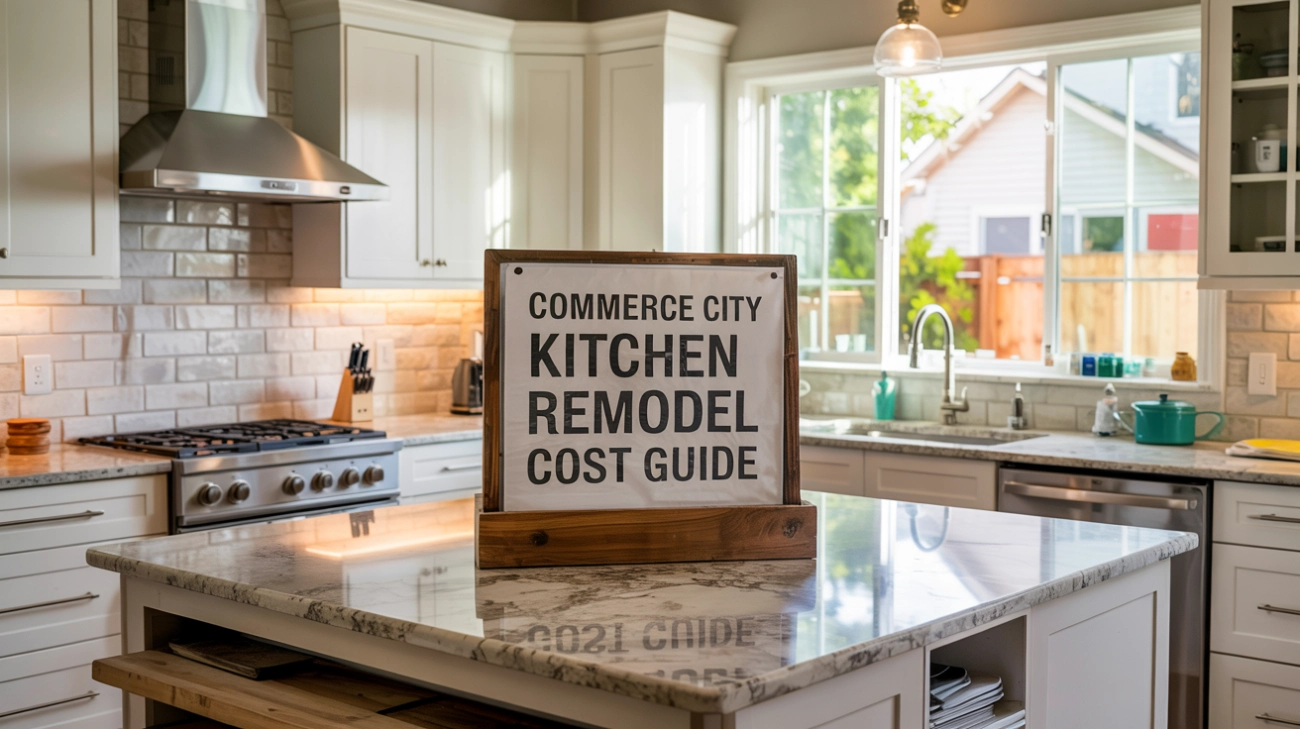
Ever wondered why your neighbor’s kitchen renovation cost half what your coworker spent? The answer isn’t just about granite versus laminate.
Kitchen remodels in Commerce City contain multitudes of variables that can dramatically shift your bottom line. From the moment you start dreaming about new countertops to the final cabinet handle installation, dozens of decisions will influence what you’ll ultimately pay.
What’s a realistic budget for your 12×15 kitchen? Will those high-end cabinets pay for themselves when you sell?
These aren’t just idle questions. They’re the difference between a smooth renovation and a financial headache that lingers long after the paint has dried.
I’ve broken down the real costs specific to Commerce City—not just national averages that don’t reflect our local market conditions. We’ll examine everything from the cost per square foot (spoiler: it varies wildly) to permit requirements you can’t afford to overlook.
By the time you finish reading, you’ll understand not just what things cost, but why they cost what they do. And that knowledge might just save you thousands.
Stable Cost Ranges per Square Foot In Commerce City, CO
Ever noticed how “$150 per square foot” gets tossed around like it’s gospel truth for kitchen renovations? The reality in Commerce City is far more nuanced.
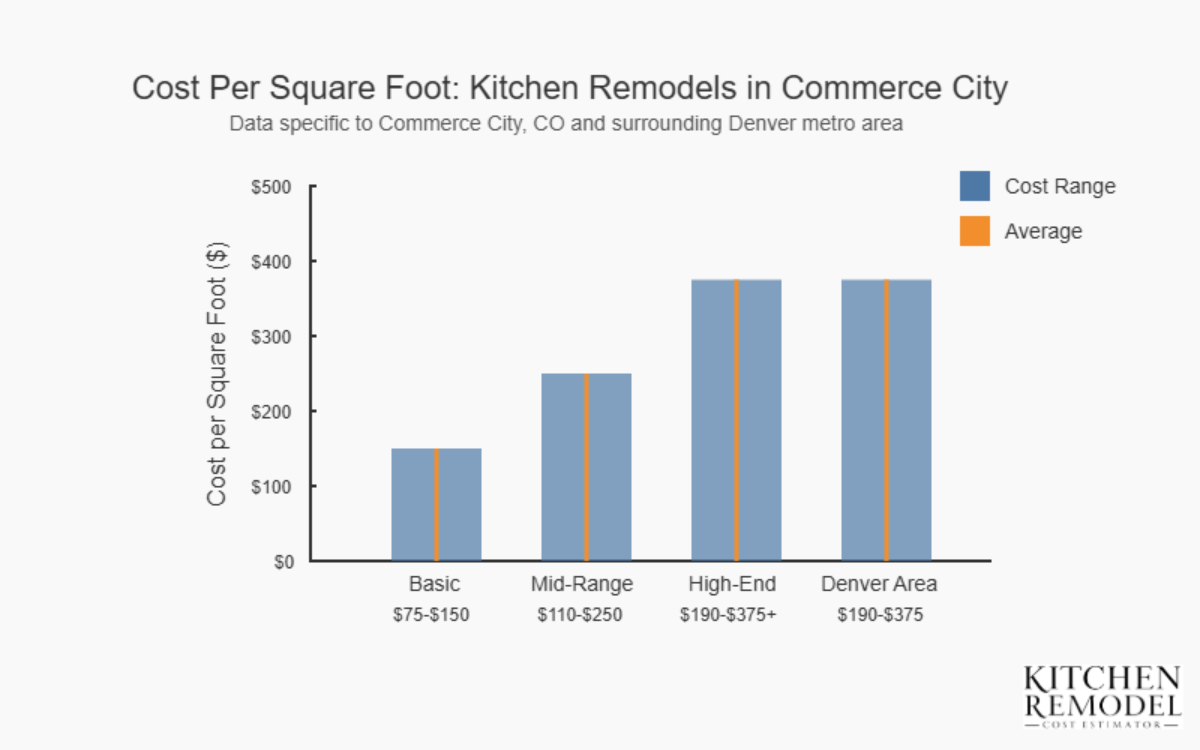
Your kitchen renovation might cost anywhere from $100 to $250 per square foot—but that’s just the starting point. Some cosmetic refreshes might run as low as $75 per square foot, while extensive renovations with premium materials can soar beyond $375.
What’s driving these differences? It’s not just about the materials you choose.
The Denver metro area, which shares market dynamics with Commerce City, typically sees costs ranging from $190 to $375 per square foot. This higher bracket often reflects our region’s specific labor rates and material transportation costs.
Project scope dramatically shifts what you’ll pay. Are you just updating surfaces, or are you moving plumbing and electrical?
Basic cosmetic renovations—think new paint, updated hardware, and minor fixes—typically run between $7,000 and $10,000 total in our area. These projects don’t change your kitchen’s footprint but can still transform its appearance.
Mid-range projects replace most elements while keeping the basic layout intact. These typically cost between $11,000 and $25,000 and include new cabinets, countertops, flooring, and appliances.
Want to start from scratch? Complete kitchen redesigns that gut the space and reconfigure the layout generally fall between $26,000 and $50,000. Luxury renovations that expand your kitchen’s footprint can easily exceed $50,000 and sometimes approach $150,000.
Your kitchen’s size inevitably affects both total cost and the per-square-foot calculation. Smaller kitchens (70-100 sq. ft.) typically range from $13,300 to $37,500 total. Medium kitchens (100-200 sq. ft.) fall between $19,000 and $75,000, while large kitchens (200+ sq. ft.) usually start around $55,000 and can exceed $112,500.
Remember that per-square-foot pricing isn’t a fixed number—it’s a range that shifts based on what you’re changing and how much space you’re working with. Rather than fixating on this single metric, consider your project’s category and overall budget range for more accurate planning.
| Remodel Type | Cost per Square Foot (Estimated Range) | Total Project Cost (Estimated Range) | Typical Scope |
|---|---|---|---|
| Basic/Cosmetic | $75 – $150 | $7,000 – $10,000+ | Repainting cabinets, new flooring, updated appliances (no layout changes) |
| Mid-Range | $110 – $250 | $11,000 – $25,000+ | Replacing cabinets, countertops, flooring, appliances (some layout changes possible) |
| High-End/Luxury | $190 – $375+ | $26,000 – $150,000+ | Complete gut and redesign, custom cabinetry, premium materials, potential structural changes/additions |
| Small Kitchen (70-100 sq. ft.) | $133 – $375 | $13,300 – $37,500 | Varies by remodel type |
| Medium Kitchen (100-200 sq. ft.) | $95 – $375 | $19,000 – $75,000 | Varies by remodel type |
| Large Kitchen (200+ sq. ft.) | $275 – $562.5+ | $55,000 – $112,500+ | Varies by remodel type |
Return on Investment (ROI) for Kitchen Remodels In Commerce City, CO
Will your kitchen renovation pay for itself when you sell? The answer depends largely on what kind of remodel you choose.
Most home remodeling projects return between 50% and 85% of their cost at resale. But in Commerce City and the surrounding Denver area, kitchen renovations specifically show a much wider range—from 38% to a remarkable 96.1%.
That difference isn’t random. It’s strategic.
Minor cosmetic upgrades deliver the highest returns by far, averaging 96-97% in the Denver area. That means for every $10,000 you spend on simple updates, you could recoup $9,600 when you sell. These high-return projects focus on surface-level changes: refacing cabinets instead of replacing them, installing mid-range countertops, adding a fresh backsplash, and upgrading to energy-efficient appliances.
Want to know the secret? These modest renovations dramatically improve appearance without moving walls or plumbing, keeping costs reasonable while maximizing visual impact.
Mid-range kitchen remodels tell a different story. When you replace cabinets and appliances entirely, ROI drops to between 49.5% and 74.8%. That’s still respectable—you’re getting back at least half your investment while enjoying the improved kitchen yourself.
Luxury renovations with custom everything? They’re the least financially efficient, averaging just 38% ROI locally. That $100,000 dream kitchen might only add $38,000 to your home’s value.
National averages reflect similar patterns: minor remodels at 81.1% ROI, mid-range major remodels at 59%, and upscale major remodels at 53.5%. But our Denver-area figures are more relevant for Commerce City homeowners.
How can you maximize your return? Focus on cost-effective upgrades rather than structural changes. Replace dated backsplashes and countertops with mid-range materials. Upgrade to energy-efficient appliances that offer immediate utility savings. Keep your existing layout when possible. Consider ready-to-assemble cabinets instead of custom options.
The data reveals a clear strategy for Commerce City homeowners: if maximizing financial return is your priority, focus on minor upgrades that refresh without reconstructing. Buyers in our market clearly value updated kitchens, but they’re not necessarily willing to pay premium prices for ultra-high-end features.
| Remodel Type | ROI in Denver, CO (Estimated) | National Average ROI |
|---|---|---|
| Minor/Cosmetic | 96-97% | 81.1% |
| Mid-Range | 49.5% – 74.8% | 59% |
| Major/Luxury | 38% | 53.5% |
Permitting Requirements and Associated Costs
Think permits are just bureaucratic red tape? They’re actually your insurance policy against costly mistakes and future liability issues.
Commerce City uses an online platform called eTRAKiT for handling the entire permitting process. From application to inspection scheduling, everything happens electronically—which means no more standing in line at city offices.
But which renovations actually require permits? This is where many homeowners get confused.
You’ll need a building permit for interior alterations that change your kitchen’s layout, structural modifications, or anything involving new plumbing fixtures and electrical appliances. Adding a sink, moving a dishwasher, installing a new range, or relocating an oven? Those all require permits.
On the flip side, you won’t need permits for purely cosmetic updates: installing new flooring, replacing countertops (without structural changes), painting walls, or swapping out kitchen cabinets. These surface-level changes fall outside the permitting requirements.
How does the permit process work in Commerce City? It starts with creating an account on the eTRAKiT portal. You’ll then need to upload all required documentation—potentially including building plans and soils reports for more extensive renovations. After submitting your application and paying any upfront fees, the city conducts a Gateway Review, followed by a more detailed Plan Review to ensure your project meets building codes.
What about costs? Permit fees in Commerce City are based on your project’s total valuation—essentially what you’re spending on the renovation. While specific Commerce City fees weren’t available in our data, nearby Denver’s structure offers a comparable reference: fees range from $20 for projects under $500 to $220 plus $8 for each additional $1,000 for projects between $25,001 and $50,000.
Total permit costs for kitchen remodels typically fall between $200 and $2,500 in the Denver metro area. For the exact fees applicable to your Commerce City project, check the eTRAKiT portal or contact the Building Safety Division directly at 303-289-3790.
Don’t forget inspections! Commerce City generally conducts inspections on the same day they’re requested, but high-volume periods might push yours to the next business day. All inspections must be scheduled through the eTRAKiT portal.
| Activity | Permit Required? | Notes |
|---|---|---|
| Interior alterations (e.g., layout changes) | Yes | Generally covers significant changes to the structure or layout. |
| New plumbing fixtures (e.g., sinks, dishwashers) | Yes | Adding or relocating plumbing fixtures typically requires a permit. |
| New electrical appliances (hardwired) | Yes | Installing new hardwired appliances like ovens or stoves may require a permit. |
| Installation/replacement of floor finishes | No | Replacing tiles, hardwood, or other flooring materials usually does not require a permit. |
| Replacement of interior finishes (non-structural) | No | Includes repainting, wallpapering, or replacing countertops without structural changes. |
| Non-structural cosmetic repairs | No | Minor updates that do not alter the structure or essential systems usually do not need a permit. |
| Kitchen cabinets (replacement) | No | Replacing kitchen cabinets generally does not require a permit. |
| Permit Fees | N/A | Based on total project valuation. Consult the eTRAKiT portal or contact the Commerce City Building Safety Division at 303-289-3790 for the specific fee schedule. Plan review fees are due at application; remaining fees due before permit issuance. |
| Inspection Scheduling | N/A | Scheduled through the eTRAKiT portal. |
Influence of Design Preferences on Costs
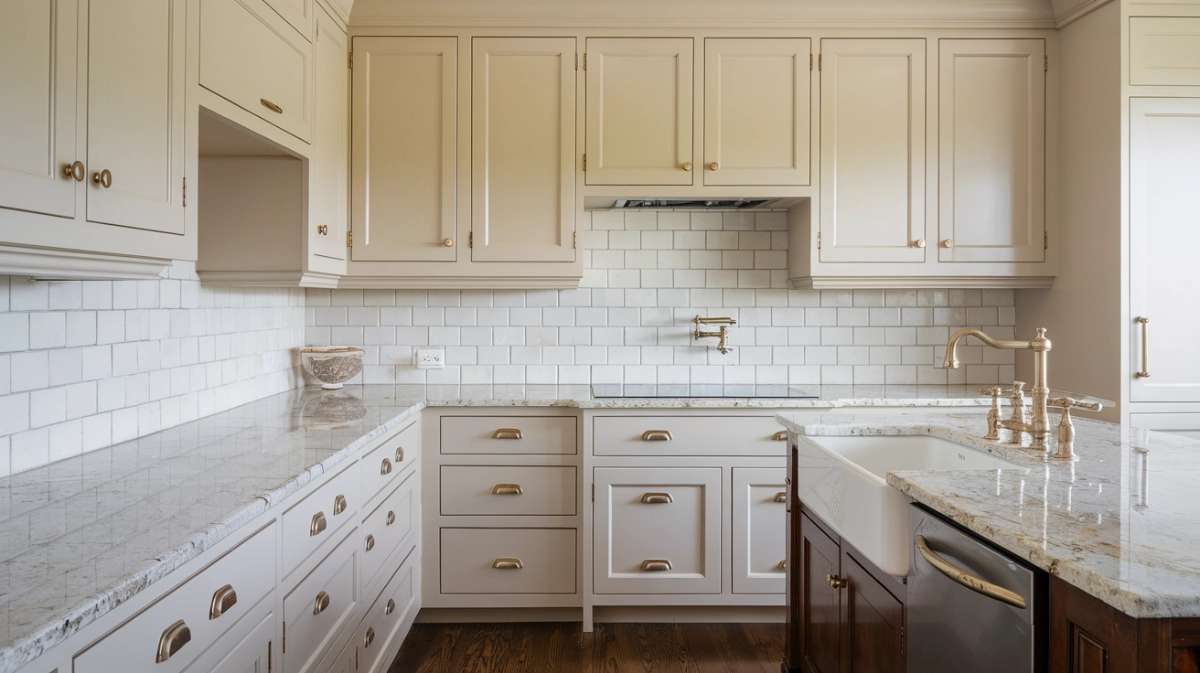
Ever wondered why two seemingly similar kitchens can have wildly different price tags? The design style you choose plays a much bigger role than you might expect.
Your aesthetic preferences don’t just affect how your kitchen looks—they fundamentally shape what materials you’ll need, what installation challenges you’ll face, and ultimately, what you’ll pay.
Commerce City homeowners tend to gravitate toward several popular design styles, including Contemporary, Modern, Traditional, Farmhouse, Transitional, Industrial, Rustic, Coastal, Craftsman, Cottage, Boho, Mediterranean, and Mid-Century Modern. Each brings its own cost implications.
Traditional kitchens typically feature hardwood cabinets with raised panels and decorative elements, often paired with natural stone countertops like granite or marble. These materials generally fall in the mid-to-high price range, with costs varying based on wood type, ornamentation level, and stone quality.
Dreaming of a sleek Contemporary kitchen? Expect flat-panel cabinets with high-gloss or textured finishes and engineered countertops like quartz or porcelain. Costs here also range from mid to high, influenced by the quality of engineered materials and the modern appliances that typically complete the look.
Farmhouse style has exploded in popularity, with its characteristic natural wood (often reclaimed), apron-front sinks, and painted cabinets in light colors. The price range here varies dramatically—reclaimed wood carries premium prices, while painted stock cabinets can be surprisingly budget-friendly. The specialty fixtures that define this style often add significant cost.
Transitional kitchens blend traditional and contemporary elements, commonly featuring Shaker-style cabinets and flexible material choices. This style generally falls into the mid-range cost category and offers more versatility in working within different budgets.
Beyond the style itself, customization level dramatically impacts your bottom line. A simple countertop replacement with stock cabinets costs significantly less than a full redesign with custom cabinetry, islands with integrated appliances, and major layout changes.
Labor costs fluctuate with design complexity too. Intricate designs or specialized materials may require skilled craftspeople commanding higher rates. Hiring a professional kitchen designer adds to your budget, but their expertise often prevents costly mistakes and can actually optimize your spending.
Some good news: The popularity of Traditional, Contemporary, and Farmhouse styles in Commerce City means more material availability and contractors experienced with these aesthetics, potentially leading to more competitive pricing. However, trending elements like natural wood tones could increase costs for materials like white oak and walnut as demand rises.
If you’re budget-conscious, consider simpler designs, readily available materials, and stock or semi-custom cabinetry to control both material and labor expenses.
| Popular Design Style | Typical Material Characteristics | Potential Cost Implications |
|---|---|---|
| Traditional | Hardwood cabinets (raised panel), decorative details, granite/marble countertops | Generally mid-to-high cost depending on wood type and level of ornamentation. Natural stone countertops can be expensive. |
| Contemporary | Flat-panel cabinets (high-gloss/textured), engineered countertops, minimalist hardware | Can range from mid-to-high cost depending on the quality of engineered materials and appliance choices. |
| Farmhouse | Natural wood (reclaimed often), apron-front sinks, open shelving, painted cabinets (light colors) | Can vary widely. Reclaimed wood can be costly, while painted stock cabinets might be more affordable. Specialty sinks can add expense. |
| Transitional | Shaker-style cabinets, versatile material choices (wood, painted), mix of traditional and modern elements | Generally mid-range cost, offering flexibility in material selection to suit different budgets. |
| Modern | Sleek lines, minimalist design, high-tech features, stainless steel accents | Can range from mid-to-high cost depending on appliance choices and the level of technology integration. |
| Rustic | Knotty wood cabinets, natural stains, distressed detailing, rubbed-brass/wrought iron hardware | Can be mid-range, but the cost of specific wood types and hardware can vary. |
Typical Materials Used and Their Cost Implications
Ever noticed how the sample countertop that caught your eye in the showroom suddenly transforms into a budget-buster when calculated for your entire kitchen? Material selection is where theoretical budgets meet financial reality.
%%{init: {'theme': 'base', 'themeVariables': { 'primaryColor': '#f0f0f0', 'primaryTextColor': '#323232', 'primaryBorderColor': '#7c7c7c', 'lineColor': '#5c5c5c', 'secondaryColor': '#e0e0e0', 'tertiaryColor': '#f4f4f4' }}}%%
flowchart TB
KitchenCost["Kitchen Remodel Total Cost\n(Commerce City, CO)"]
KitchenCost --> Cabinets["Cabinets\n29%\n$5,000-$25,000"]
KitchenCost --> Appliances["Appliances\n14%\n$2,000-$10,000"]
KitchenCost --> Countertops["Countertops\n10-15%\n$50-$250/sq ft"]
KitchenCost --> Flooring["Flooring\n7%\n$1,000-$8,000"]
KitchenCost --> Labor["Labor\n20-35%"]
KitchenCost --> Permits["Permits & Fees\n$200-$2,500"]
classDef primary fill:#4e79a7,stroke:#333,stroke-width:1px,color:white
classDef secondary fill:#f28e2c,stroke:#333,stroke-width:1px,color:white
classDef tertiary fill:#59a14f,stroke:#333,stroke-width:1px,color:white
classDef quaternary fill:#e15759,stroke:#333,stroke-width:1px,color:white
classDef quinary fill:#76b7b2,stroke:#333,stroke-width:1px,color:white
classDef senary fill:#edc949,stroke:#333,stroke-width:1px,color:white
class KitchenCost primary
class Cabinets secondary
class Appliances tertiary
class Countertops quaternary
class Flooring quinary
class Labor secondary
class Permits senaryThe Denver metro area, including Commerce City, offers nearly endless material options—each with distinct price points and performance characteristics that directly impact your bottom line.
Countertop Materials: The Visual Centerpiece
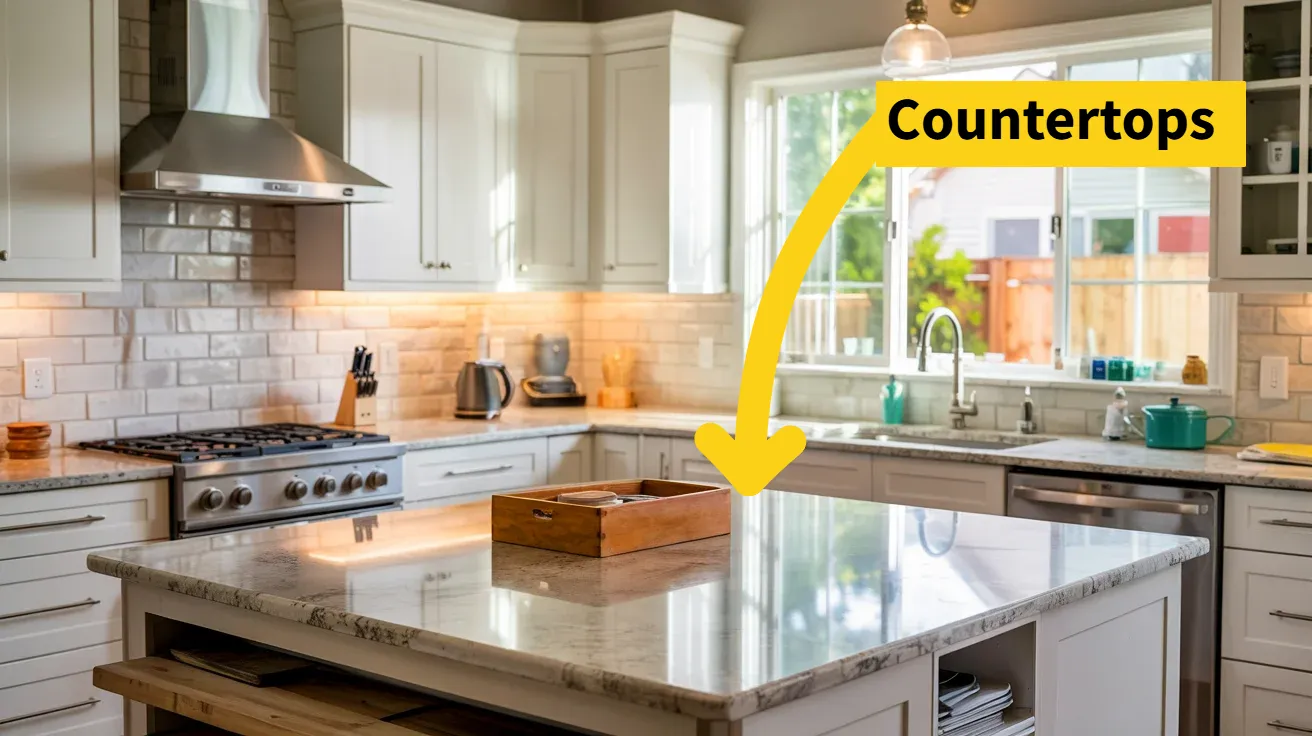
Your countertop choice might represent the single most visible decision in your kitchen remodel. It’s also where costs can swing dramatically.
Granite, the perennial favorite for its durability and heat resistance, typically runs between $50 and $150 per square foot installed. But there’s a catch—it requires periodic sealing to maintain its performance.
Quartz has surged in popularity for good reason. This engineered stone offers exceptional stain resistance and virtually zero maintenance, with costs ranging from $55 to $125 per square foot installed.
Marble delivers undeniable elegance but comes with vulnerabilities—it’s more susceptible to staining and etching. Expect to pay between $75 and $250 per square foot installed for this luxury option.
Budget-conscious renovators often turn to laminate, while those seeking warmth might consider butcher block (though it requires regular oiling). Soapstone offers impressive durability and heat resistance for those willing to embrace its distinctive look.
Newer engineered stones like porcelain are gaining traction for their versatility and durability, with prices varying based on brand and specifications.
Cabinet Types: The Budget’s Biggest Line Item
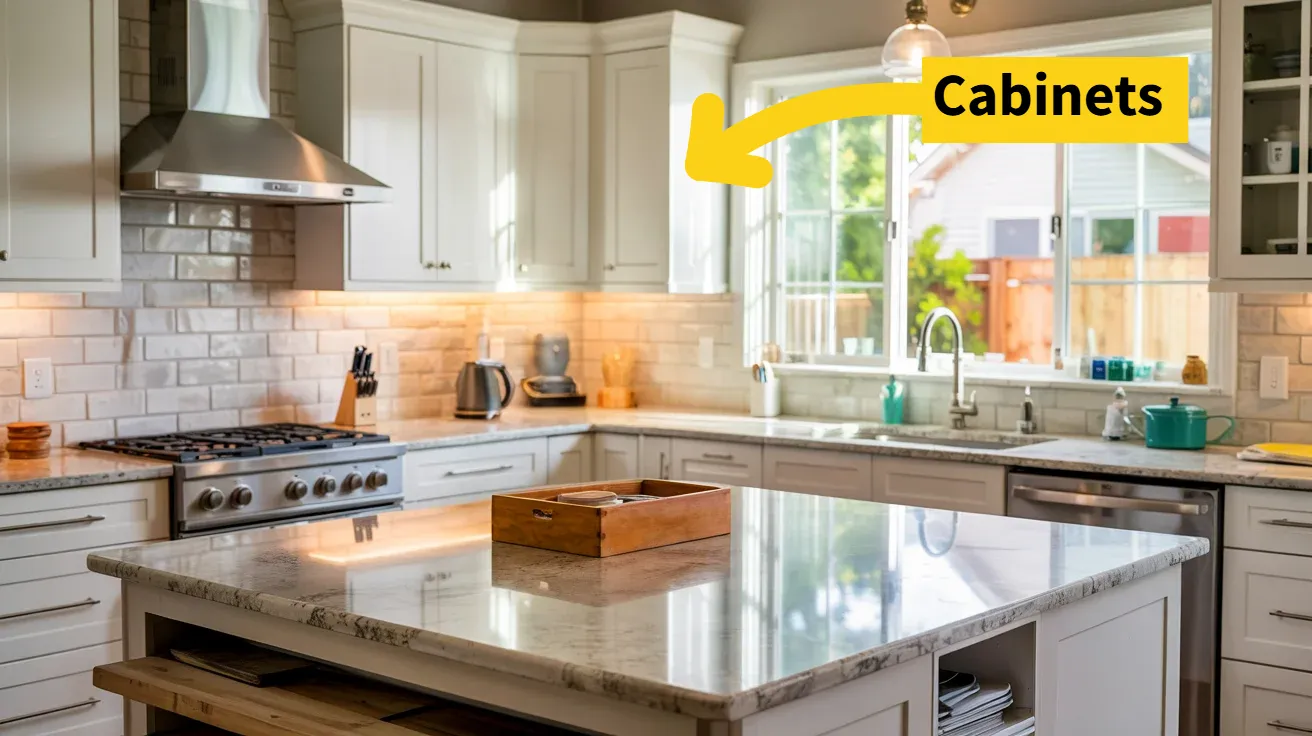
Did you know cabinets typically consume about 29% of a kitchen remodel budget? That makes your cabinet decisions particularly consequential for controlling costs.
Stock cabinets offer the most affordable option—they come in predetermined sizes and finishes. Semi-custom cabinets provide more flexibility with some size adjustments and finish options. Fully custom cabinets deliver exactly what you want but at premium prices.
For the budget-conscious, consider cabinet refacing rather than replacement—this approach can deliver a fresh look at roughly half the cost.
Cabinet styles reflect the overall kitchen design, with Traditional, Contemporary, and Farmhouse being particularly popular in Commerce City. Materials range from solid woods (maple, oak, cherry, hickory) to painted wood, wood veneer, thermofoil, and laminate.
Professional cabinet installers generally prefer plywood for cabinet box construction due to its superior stability and durability.
Depending on your selections, expect to spend between $5,000 and $25,000 on cabinetry alone.
Flooring Options: The Foundation of Your Design

Your kitchen floor takes more abuse than perhaps any surface in your home. It needs to withstand spills, dropped items, temperature changes, and constant foot traffic.
Vinyl flooring, particularly luxury vinyl plank (LVP), has revolutionized kitchen flooring with its durability, water resistance, and affordability. Modern vinyl can convincingly mimic the look of hardwood or stone at a fraction of the cost.
Ceramic and porcelain tile offer exceptional durability and nearly limitless design options. With proper installation, these materials can last decades.
Hardwood brings timeless appeal but requires careful consideration in Colorado’s dry climate. Engineered hardwood often provides better stability than solid hardwood in our environment.
Expect flooring to consume about 7% of your total remodel budget, with material and installation expenses ranging from $1,000 to $8,000 depending on your selections and kitchen size.
Appliance Categories: From Basic to Smart
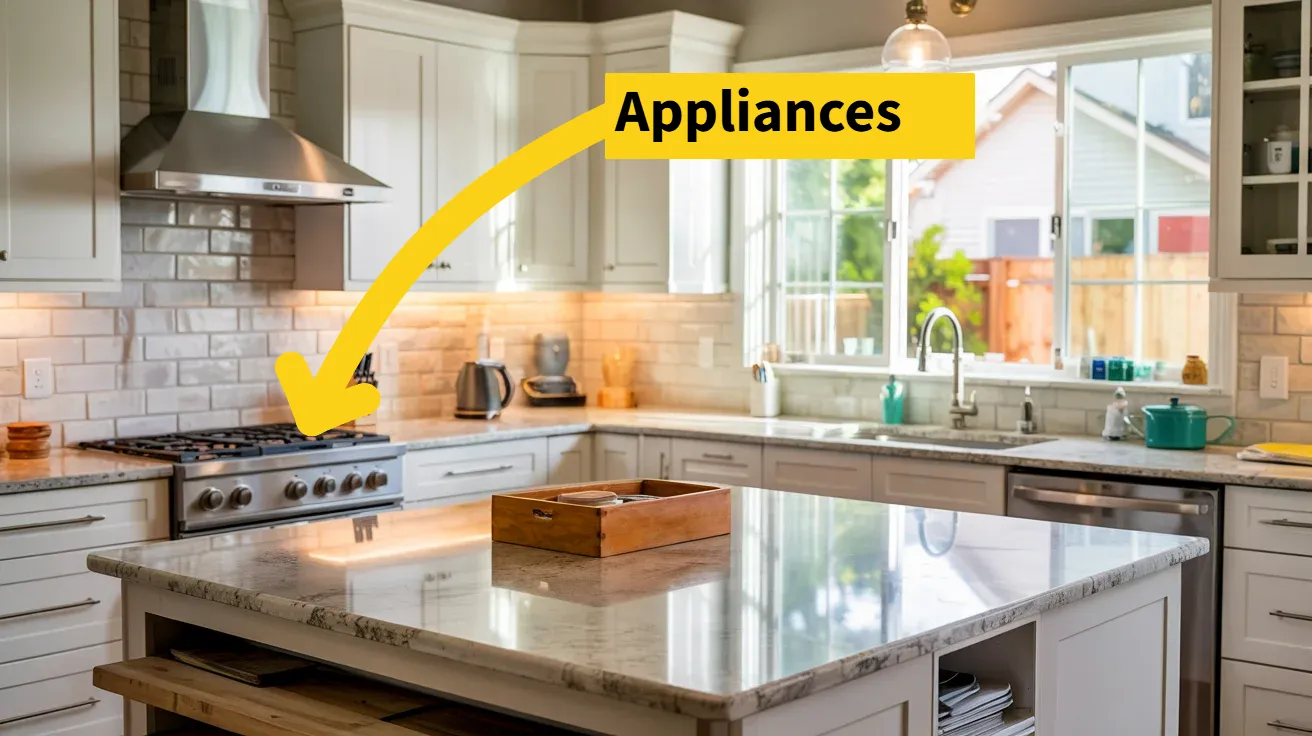
Appliances typically account for around 14% of your kitchen renovation budget. The range is vast—from basic models in budget renovations to energy-efficient options and high-end, luxury appliances in premium projects.
Smart appliances with advanced technological features continue gaining popularity despite their higher price points. Common brands available locally include GE, LG, KitchenAid, Samsung, Whirlpool, Bosch, Viking, and Thermador.
Plan to spend between $2,000 and $10,000 for new appliances, depending on your performance and feature requirements.
The material options available in Commerce City give you tremendous flexibility to customize your kitchen according to both your design vision and financial constraints. Energy-efficient options continue to gain market share, reflecting growing awareness of both environmental impact and long-term operational savings.
| Material Category | Common Examples | Typical Cost Range (Installed, Where Specified) | Key Considerations |
|---|---|---|---|
| Countertops | Granite, Quartz, Laminate, Marble, Butcher Block, Soapstone, Engineered Stone (Porcelain) | Granite: $50-$150/sq. ft.; Quartz: $55-$125/sq. ft.; Marble: $75-$250/sq. ft. | Durability, maintenance, aesthetics, cost |
| Cabinets | Stock, Semi-Custom, Custom; Solid Wood, Painted Wood, Veneer, Thermofoil, Laminate | Overall range: $5,000 – $25,000 (varies greatly) | Style, material, level of customization, storage needs |
| Flooring | Vinyl (LVP), Tile (Ceramic, Porcelain), Hardwood (Engineered, Solid), Stone, Laminate | Overall range: $1,000 – $8,000 (materials & installation) | Durability, water resistance, aesthetics, maintenance, climate suitability |
| Appliances | Basic, Energy-Efficient, High-End/Luxury; Brands like GE, LG, KitchenAid, Samsung, Bosch | Overall range: $2,000 – $10,000 | Functionality, energy efficiency, brand reputation, features, aesthetics |
Application of Recognized Standards (ASTM)
Ever wondered why some kitchens seem to age poorly while others last decades? The difference often comes down to unseen standards applied during construction.
Recognized industry standards, particularly those from ASTM International, serve as the invisible framework ensuring your kitchen materials and construction practices meet proven quality, safety, and performance benchmarks.
Countertop Standards: Beyond Surface Beauty
When selecting countertops, you’re not just choosing an aesthetic—you’re selecting materials that need to withstand years of use and abuse.
ANSI/AWI 1236-2022 establishes structural requirements covering load resistance, deflection limits, overhang restrictions, and material specifications for laminate, solid surface, and natural stone countertops. This standard references ASTM D1037 for measuring thickness swelling in substrates—critical for predicting how your countertop will respond to moisture exposure.
If you’re considering natural stone, ASTM C1528/C1528M-18 provides construction guidelines specific to these materials. For granite specifically, ASTM C97 measures absorption rates, a key indicator of how likely your countertop is to stain.
Quartz surfaces fall under ISFA 3-01 (2013), which classifies and standardizes these engineered materials.
Cabinet Construction: Structural Integrity Matters
Your cabinets do more than store dishes—they form the structural backbone of your kitchen.
ASTM D1037 evaluates the physical and mechanical properties of particleboard and medium-density fiberboard (MDF) commonly used in cabinet chassis and doors. These materials are further regulated by ANSI A208.1 for particleboard and ANSI A208.2 for MDF.
Concerned about indoor air quality? ASTM D6007 tests formaldehyde concentrations emitted from wood products, including those used in kitchen cabinets. This helps ensure your beautiful new kitchen isn’t releasing harmful chemicals into your home.
Flooring Standards: Performance Under Pressure
Kitchen floors face moisture, impact, and constant wear—making standards particularly critical for this component.
ASTM F1700 specifies requirements for solid vinyl floor tiles, addressing everything from material composition and dimensions to flexibility, stability, and chemical resistance.
For the increasingly popular rigid core flooring, ASTM F3261 focuses on wear performance and stability. Sheet vinyl backing falls under ASTM F1303, while ASTM F924 measures puncture resistance—important if you drop a kitchen knife or heavy pot.
Moisture issues can destroy even the best flooring. ASTM F3191 assesses subfloor water absorption, while the recently approved ASTM F3513 sets standards for moisture mitigation systems that protect your investment from water damage.
Preparing for installation? ASTM F710 guides concrete floor preparation before installing resilient flooring.
Kitchen Construction and Safety: Protecting Your Investment
Beyond individual components, overall kitchen construction has its own standards.
ASTM E3087 measures capture efficiency of domestic range hoods—critical for maintaining indoor air quality, especially with gas ranges. ASTM E84 tests surface burning characteristics of building materials used throughout your kitchen.
For those incorporating professional-grade ventilation, ASTM F1704 tests capture performance of commercial exhaust systems.
Even the construction management process has standards—ASTM E2083 classifies field requirements, office overhead, and profit factors used in estimating your project costs.
These standards might seem technical and behind-the-scenes, but they’re your assurance that your new kitchen will perform as expected for years to come. When selecting contractors, ask about their familiarity with relevant ASTM standards—it’s a strong indicator of quality workmanship.
| Kitchen Component | Relevant ASTM Standards | Description |
|---|---|---|
| Countertops | ANSI/AWI 1236-2022, ASTM D1037, ASTM C1528/C1528M-18, ASTM C97, ISFA 3-01 (2013) | Covers structural requirements, material characteristics, natural stone use, granite absorption rate, and quartz surfacing standards. |
| Cabinets | ASTM D1037, ANSI A208.1, ANSI A208.2, ASTM D6007 | Addresses physical and mechanical properties of particleboard and MDF, and formaldehyde emission rates from wood products. |
| Flooring | ASTM F1700, ASTM F3261, ASTM F1303, ASTM F924, ASTM F3191, ASTM F3513, ASTM F710 | Specifies requirements for solid vinyl tiles, rigid core flooring, sheet vinyl, puncture resistance, subfloor water absorption, moisture mitigation systems, and concrete floor preparation. |
| Ventilation | ASTM E3087, ASTM F1704 | Provides test methods for measuring the capture efficiency of domestic and commercial range hoods. |
| Fire Safety | ASTM E84 | Assesses the surface burning characteristics of building materials. |
| Construction Management | ASTM E2083 | Offers a classification for field requirements, office overhead, and profit in construction estimating. |
Conclusion
The numbers tell the story: $75 to $375 per square foot separates a basic refresh from a premium transformation in Commerce City kitchens.
Want the smartest investment? Minor cosmetic updates deliver a stunning 96-97% ROI locally, while luxury renovations return just 38% of their cost. The math is clear for sellers.
Your choice of materials creates countless opportunities to control costs. Remember that cabinets alone consume nearly a third of most renovation budgets.
Design preferences aren’t just aesthetic choices—they’re financial decisions. Traditional, Contemporary, and Farmhouse styles remain Commerce City favorites, each with distinct price implications.
Don’t skip permits for layout changes or new plumbing/electrical work. The eTRAKiT portal makes compliance straightforward, with costs scaling to your project’s value.
By understanding these local factors, you’ll create a kitchen that satisfies both your design vision and financial reality—whether you’re cooking in it for decades or staging it to sell next month.

